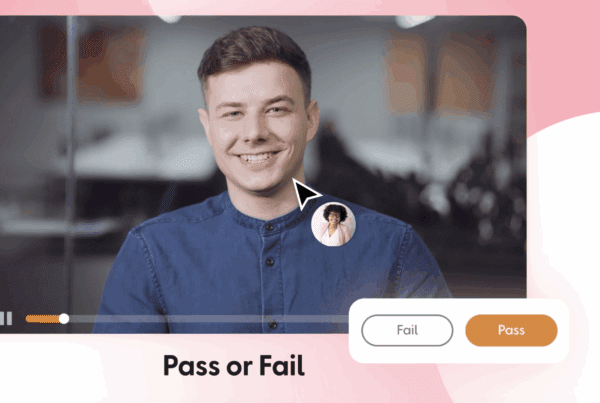(Yes, really)
More often than not, when people hear “compliance training,” their brains check out before the intro slides even load up on the screen.
And we get it.
Historically, compliance has had all the excitement of reading a toaster manual.
But here’s the thing: It really doesn’t have to be that way.
Compliance training can be a meaningful, even enjoyable experience.
All you need is the right approach.
Here are 10 proven ways to turn your compliance content from “mandatory snooze-fest” into something your people might (shock!) actually want to complete.👇
1. Tell Stories, Not Just Rules
Forget the jargon. Stories beat legislation every time.
It’s one thing to say, “Employees must never share client data outside of secure systems.”
It’s another to tell the story of how a well-meaning team member forwarded a file via personal email and how that simple mistake cost the business thousands.
Real-life case studies, cautionary tales, and even a cheeky “what-would-you-do?” dilemma go a long way. They help your learners emotionally connect with the why behind the rule, not just the what.
For example:
- Instead of listing anti-bribery laws, walk your learners through a scenario in which a sales rep is offered an expensive gift. Let them explore the grey areas before revealing the right course of action.
- When explaining GDPR, share a quick story of how a slight lapse in data handling led to a major reputational hit.
- Use internal anecdotes (anonymised, of course) to highlight what great compliance behaviour looks like and celebrate it.
Paint the picture, set the scene, and show the consequences, the good, the bad, and the avoidable.
2. Use Interactive Scenarios
Instead of telling learners what they should do, let them figure it out for themselves safely and without the real-world consequences.
This is where interactive scenarios come into their own.
Why not try branching decision trees, mini role-play quizzes, or “choose your own outcome” simulations that mirror actual workplace dilemmas?
For example:
- A procurement manager is offered a last-minute discount, but only if they skip the usual approval process. What should they do?
- A team leader notices a colleague regularly arriving late and looking stressed. Could it be burnout or a personal issue? The learner chooses how to handle it.
- A client asks a sales rep to “bend the rules just a little.” What are their options? And what happens next, depending on the path they take?
Add instant feedback at each step. If they choose the wrong path, explain the consequences but do it constructively, not punitively. If they get it right, reinforce the decision and link it back to the policy or principle.
This isn’t about catching people out. It’s about giving them a safe space to practise judgment calls and build confidence in applying rules to reality.
It’s still compliance, there’s no getting around that.
But with a bit of creativity, it becomes experiential, relevant, and even… kinda fun?
3. Break It into Bite-Sized Lessons
Long-form modules? Not in 2025.
Modern learners, especially those working in SMEs, don’t have an hour to block out for “Data Protection: Part 5.” Keep it light and mobile-friendly.
Try 3–5 minute micro-lessons that learners can dip in and out of in the flow of work.
It’s about reducing friction (our bread and butter here at Thirst 😉).
Need help structuring microlearning? Here’s how Thirst keeps learning in the flow of work
4. Gamify the Experience
No, you don’t need to build a full-on compliance escape room (though… how fun would that be?).
But even simple game mechanics like points, badges, timers, or progress bars can work wonders for engagement. Especially in team-based environments, where a little friendly competition gets people properly fired up.
Here’s how it might look in practice:
- Award digital badges for completing modules or getting full marks on scenario-based quizzes. Maybe even a cheeky “Compliance Champ” badge for finishing all training early.
- Add a leaderboard that updates in real time, ideal for teams who like to see where they stand. It can turn a solo task into a team buzz.
- Break content into “levels,” where unlocking one topic gives access to the next. Bonus: it creates a sense of progression and achievement.
- Use time-based challenges like “complete this quiz in under 2 minutes” to encourage quick thinking and retention.
And no, it’s not about dumbing things down.
Gamification is about tapping into what motivates people: progress, recognition, and maybe even a little glory. It makes the learning journey feel rewarding, not just obligatory.
Because let’s be honest: if a pop-up badge makes someone smile while learning anti-bribery policy, that’s a win in our book.
5. Add Humour (Carefully)
When done right, humour doesn’t just entertain, it helps learning stick.
A well-timed joke, a clever analogy, even a cheeky meme, can cut through the dry tone compliance training is infamous for. It makes the content more human, more relatable, and more likely to be remembered.
For example:
- Explaining password security? Try: “Your password should be like your toothbrush: unique, hard to guess, and never shared with colleagues.”
- Highlighting anti-bribery policies? A meme showing someone rejecting a suspicious “gift” with the caption “Nice try, but I like my job too much.”
- Are you addressing GDPR? Cue a gif of someone frantically shredding paper with the caption: “When someone says they didn’t get consent to store personal data…”
If it fits your culture, especially in smaller, tight-knit teams, humour can make training feel more like a conversation and less like a lecture.
That said, it comes with a clear warning: Don’t make light of serious, sensitive topics like harassment, discrimination, or workplace safety. The line between light-hearted and inappropriate can get blurry fast, so always sense-check with HR or a trusted colleague if you’re unsure.
The golden rule? Be playful, not flippant. Make it feel human, not hollow. And when in doubt, aim for smiles, not snorts.
6. Use Video (Please, Just Use Video)
There’s no getting around it: when it comes to engagement, video wins. Every time.
Whether it’s an animated explainer, a short talking head from your HR lead, or a simple screen recording with voiceover, video brings compliance topics to life in a way static slides just… don’t.
It’s visual. It’s dynamic. And crucially, it respects the fact that your learners are humans, not robots.
Here are a few easy wins:
- Use a short animated video to break down something complex, like whistleblowing procedures or data protection steps.
- Film a leader or manager talking directly to their team about why this training matters to them, adding that all-important personal context.
- Create a mini “day-in-the-life” compliance walk-through. For example, follow an employee as they spot and report a potential conflict of interest, showing the process in action.
- Drop in short clips during modules to switch things up and re-engage attention mid-course.
And no, you don’t need a full production studio or Hollywood lighting. A clear script, a half-decent mic, and a quiet meeting room are usually enough.
The aim isn’t perfection. It’s a connection.
When learners can see real people talking about real issues, it builds trust, makes the message resonate, and might just stop them from zoning out by slide 3.
7. Personalise the Learning Path
Finance doesn’t need the same compliance training as Marketing, and your London team might face different regulations than your US crew.
With an AI-powered platform like Thirst (yep, shameless plug there, sorry), you can tailor learning paths to roles, departments, or even individuals so that no one has to sit through irrelevant content.
Personal relevance = attention retained.
Find out how Thirst delivers tailored learning experiences.
8. Create Peer-Led Learning Moments
Compliance doesn’t have to be a solo activity. In fact, it probably shouldn’t be.
One of the most potent ways to make compliance stick is to turn it into a team conversation, not just an individual task. When people learn with and from each other, the content feels more relevant, more real, and way less like a box-ticking chore.
Here’s how you can spark those moments:
- Run short “What would you do?” roundtables in team meetings. Use a scenario, e.g. “You see a colleague accessing files they shouldn’t have. What’s your move?” and let the discussion unfold.
- Set up Slack or Teams threads where employees can share tips, ask questions, or react to real-world compliance challenges. (Bonus points if leadership chimes in.)
- Turn compliance training into a mini team challenge. Who can score the highest on the anti-bribery quiz? Who finishes all their modules first?
- Encourage managers to host 5-minute debriefs after a learning module. There is no pressure; it should be a quick “what stood out to you?” conversation that reinforces key points.
- If needed, invite a peer to share a quick story about a compliance issue they’ve navigated anonymously. It makes the policy personal.
When people learn together, they remember more. Just as importantly, they feel more accountable to each other, not just to a faceless LMS.
Make it a conversation. Make it collaborative.
9. Reinforce in Real Time
Pop-up quizzes. In-the-moment nudges. Mini recaps a few days later.
You don’t need to save feedback for the final quiz.
Reinforce as learners go… it keeps them active, alert, and learning in the moment.
(And if your Learning Platform makes this easy? Even better.)
Curious about how Thirst handles real-time nudges?
Check out our guide to building learning journeys that adapt to your people.
10. Make It Ridiculously Easy to Access
Compliance already has a reputation for being hard work.
Don’t let your platform add to the pain. Think mobile-first, with fast load times, intuitive design, and no clunky portals.
No endless clicks. Just tap, learn, done.
Remove the barriers. Boost the buy-in.
We can help with all of this, but more on that later…
Final Thoughts
Compliance doesn’t have to suck.
And it definitely doesn’t have to send your learners into nap mode.
With the right mix of storytelling, interactivity, and smart delivery, you can turn
“Have to do it” into “Hey, that was actually useful.”
And when you do that?
You’re building a culture where doing the right thing becomes second nature.
Got 2 Minutes?
If your organisation is struggling with disengaged learners, Thirst has the solution.
Thirst is an AI-powered learning platform that helps L&D teams of all sizes boost learner engagement and create experiences tailored to today’s learners.
Take a guided tour today and see Thirst in action.
For more e-learning insights, resources and information, discover the Thirst blog.
You may also enjoy:
70:20:10 Learning Model: How to Use it for L&D | Employee Preboarding: Steps to Wow New Hires | What is Adaptive Learning: A Beginner’s Guide







